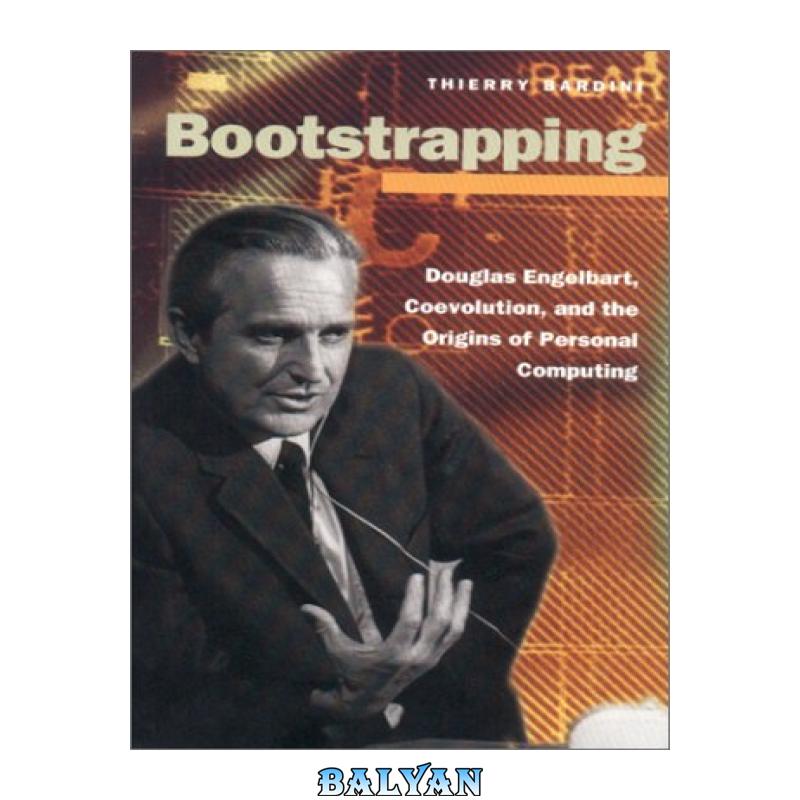
دانلود کتاب Bootstrapping: Douglas Engelbart, Coevolution, and the Origins of Personal Computing (Writing Science) (به فارسی: Bootstrapping: Douglas Engelbart، Coevolution، و ریشه های محاسبات شخصی (علم نوشتن)) نوشته شده توسط «Thierry Bardini»
اطلاعات کتاب Bootstrapping: Douglas Engelbart، Coevolution، و ریشه های محاسبات شخصی (علم نوشتن)
موضوع اصلی: سازمان و پردازش داده ها
نوع: کتاب الکترونیکی
ناشر: Stanford University Press
نویسنده: Thierry Bardini
زبان: English
فرمت کتاب: djvu (قابل تبدیل به سایر فرمت ها)
سال انتشار: 2000
تعداد صفحه: 309
حجم کتاب: 4 مگابایت
کد کتاب: 9780804738712 , 0804738718
نوبت چاپ: 1
توضیحات کتاب Bootstrapping: Douglas Engelbart، Coevolution، و ریشه های محاسبات شخصی (علم نوشتن)
مخاطب: دانشگاهیان، مورخان جزئیات گرا تعامل کامپیوتری
من این کتاب را به دنبال تاریخچه مفصلی از کار داگلاس انگلبارت خریدم و باردینی مطمئناً آن را ارائه می دهد. در واقع جزئیات بیش از حد. نتیجه یک تاریخچه بسیار کامل و مفصل است، اما تاریخچه ای که خواندن آن جذاب نیست و در پیچ و خم های کوچک است. همانطور که نوشته شده است، این فقط برای کسانی است که عمیقاً به تاریخچه سیستم NLS علاقه مند هستند و به اندازه کافی صبور هستند تا موضوعات فرعی را به ضمیمه ها رها کنند. برای اینکه مخاطبان بیشتری را مورد توجه قرار دهد، نیاز به ویرایش و بازنویسی جدی دارد تا قوس داستانی به تاریخ ارائه شود.
جزئیات:
واضح است که باردینی به بسیاری از افراد کلیدی گروه انگلبارت و همچنین آرشیوها دسترسی بی سابقه ای داشته است. این بدان معناست که او فرصتی بی نظیر برای نوشتن تاریخ قطعی داشت. مشکل یکی از ویرایش است. اغلب احساس میکند که با داشتن این همه اطلاعات تصمیم میگیرد بیشتر از آنچه برای روایت داستان مناسب است، از آن استفاده کند. نتیجه پایان نامه دکتری مشروح فراوان است و نه یک داستان (سلام) جذاب.
برای مثال، تأثیر جنبشهای دوران دهه 60 مانند est که در گزارشهای SRI بایگانی شده است، به طور گسترده دنبال میشود، از جمله چندین صفحه از ارائه مجدد داستان کتاب دیگری در رویداد. نویسنده به جزئیات بزرگی از پویایی گروه میپردازد که باید پوشش داده شود و ارزش دنبال کردن را دارد – گویی این جدید، منحصر به فرد یا خاص بود به دلیل زمان و مکانی که گروه در آن کار میکرد. مطمئناً ظرافتهای خاص خود را داشت، اما میتوانست آن را در چند صفحه (یا پاراگراف) خلاصه کند تا داستان به امتداد ادامه یابد.
برخلاف موضوعات نوار کناری، “مادر همه دموها” معروف 1968 تقریباً به عنوان یک فکر بعدی ارائه شده است. به نظر میرسد نویسنده این را مسلم میداند که خواننده ویدیو را دیده است (امروزه انجام آن آسانتر از زمانی است که کتاب در سال 2000 منتشر شد) و برای به تصویر کشیدن تأثیری که داشته است، کاری انجام نمیدهد. هیچ توضیح یا رونوشتی وجود ندارد. فقط چند عکس، چند نظر و فهرستی خشک از تلاش عمده ای که نشان می دهد. به نظر می رسد آنچه که باید نقطه اوج کتاب باشد (حتی “”) با توضیحات و جزئیات کمتری نسبت به بسیاری از موضوعات فرعی دیگر می گذرد.
گفتنی است، خواننده اختصاصی درک بسیار عمیق تری از آنچه داگ را هدایت کرد و چگونه گروهش تجربه محاسباتی را که ما اکنون بدیهی می دانیم ایجاد کرد، دریافت خواهد کرد. این تصویر بزرگتری از پیشرفت چشم انداز ارائه می دهد. این تمایز بین “افزایش کاربر” و “کاربر پسند” را روشن می کند، اما واقعاً تا به امروز این تمایز را دنبال نمی کند. زمانی که پروژه NLS به پایان می رسد (1974) متوقف می شود و هیچ چیز از کار داگ یا موضوعات به جلو را دنبال نمی کند. بخش “coda” تلاش می کند تا کار را در چشم انداز قرار دهد اما به سرعت در جهت های مختلف می چرخد و تمرکز ندارد.
I bought this book looking for a detailed history of Douglas Engelbart’s work and Bardini certainly delivers that. Actually too much detail. The result is a very thorough and detailed history, but one that’s not engaging to read and meanders into minutia. As written, it’s for only those deeply interested with the NLS system history and patient enough to wade through sub-topics better left to appendices. To be of interest to a wider audience it needs serious editing and rewriting to provide a story arc to the history.
Details:
It’s clear that Bardini had unprecedented access to many of the key people from Engelbart’s group as well as the archives. This means he had a unique opportunity to write a definitive history. The problem is one of editing; it often feels like having that having all this information at hand he decided to incorporate more of it than appropriate for a story narrative. The result is copiously annotated doctoral thesis and not an engaging (hi-)story.
For example, impact of ’60s era movements like est as archived in the SRI logs is extensively tracked including several pages of re-presenting another book’s story on the event. The author goes into great details of the group dynamics need to be covered and are worthy of following -as if this was new, unique or special because of the time and place where the group worked. Certainly it had its particular nuances, but it could have been summarized in a just a few pages (or paragraphs) to keep the story moving along.
In contrast to the sidebar topics, the famous 1968 “Mother of All Demos” is presented almost as an afterthought. The author seems to take for granted that the reader has seen the video (something easier to do today than when the book came out in 2000) and does little to really capture the impact it had. There’s no description or transcript; just a few photos, some comments and a dry inventory of the major effort it represented. What should be a (even “the”) climax to the book seems to pass by with less description and detail than many other lesser sub-topics.
That said, the dedicated reader will get a much deeper understanding of what drove Doug and how his group created the computing experience we now take for granted. It does provide the greater picture of how far advanced the vision was. It clarifies the distinction between “user augmentation” and “user friendly” but doesn’t really follow that through to the current day. It stops when the NLS project ends (1974) and doesn’t follow anything of Doug’s work or the themes forward. The “coda” section makes some effort to put the work into perspective but quickly spins in multiple directions and lacks focus.
دانلود کتاب «Bootstrapping: Douglas Engelbart، Coevolution، و ریشه های محاسبات شخصی (علم نوشتن)»

برای دریافت کد تخفیف ۲۰ درصدی این کتاب، ابتدا صفحه اینستاگرام کازرون آنلاین (@kazerun.online ) را دنبال کنید. سپس، کلمه «بلیان» را در دایرکت ارسال کنید تا کد تخفیف به شما ارسال شود.